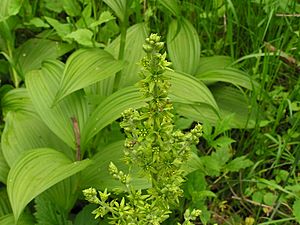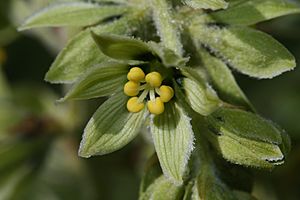Veratrum viride facts for kids
Quick facts for kids Veratrum viride |
|
|---|---|
 |
|
| Veratrum viride var. viride in flower | |
| Scientific classification | |
| Genus: |
Veratrum
|
| Species: |
viride
|
| Synonyms | |
|
Synonymy
Helonias viridis (Aiton) Ker Gawl.
Veratrum lobelianum var. eschscholtzianum Schult. & Schult.f., syn of var. eschscholzianum Veratrum eschscholtzianum (Schult. & Schult.f.) O.Loes., syn of var. eschscholzianum Veratrum eschscholtzii A.Gray, syn of var. eschscholzianum Veratrum viride var. escholtzianoides O.Loes., syn of var. eschscholzianum Veratrum eschscholtzii var. incriminatum B.Boivin, syn of var. eschscholzianum Veratrum eschscholtzii var. typicum B.Boivin, syn of var. eschscholzianum Veratrum viride subsp. eschscholtzii (A.Gray) Á.Löve & D.Löve, syn of var. eschscholzianum |
|
Veratrum viride, known as Indian poke, corn-lily, Indian hellebore, false hellebore, green false hellebore, or giant false-helleborine, is a species of Veratrum native to eastern and western (but not central) North America. It is extremely toxic, and is considered a pest plant by farmers with livestock. The species has acquired a large number of other common names within its native range, including American false hellebore, American white hellebore, bear corn, big hellebore, corn lily, devils bite, duck retten, itch-weed, itchweed, poor Annie, blue hellebore and tickleweed.
Description

V. viride is a herbaceous perennial plant reaching 0.7 to 2 metres (2.3 to 6.6 ft) tall, with a solid green stem. The leaves are spirally arranged, 10 to 35 cm (4 to 14 in) long and 5 to 20 cm (2 to 8 in) broad, elliptic to broad lanceolate ending in a short point, heavily ribbed and hairy on the underside. The flowers are numerous, produced in a large branched inflorescence 30 to 70 cm (1.0 to 2.3 ft) tall; each flower is 5 to 12 mm (0.2 to 0.5 in) long, with six green to yellow-green tepals. The fruit is a capsule 1.5 to 3 cm (0.6 to 1.2 in) long, which splits into three sections at maturity to release the numerous flat 8 to 10 mm (0.3 to 0.4 in) diameter seeds. The plant reproduces through rhizome growth as well as seeds.
Varieties and similar species
There are two recognized varieties of V. viride:
- Veratrum viride var. viride is found in eastern North America. It is differentiated by the erect or spreading side branches of the inflorescence.
- Veratrum viride var. eschscholzianum is found in western North America. It is differentiated by the drooping side branches of the inflorescence.
The related western North American Veratrum californicum (white false hellebore, corn lily) can be distinguished from sympatric var. eschscholzianum by its whiter flowers and the erect side branches of the inflorescence.
Distribution and habitat
In eastern North America, var. viride occurs from southwestern Labrador and southern Quebec south to northern Georgia. In the west, var. eschscholzianum occurs from Alaska and Northwest Territory south through Yukon, British Columbia, Alberta, Washington, Idaho, Montana, and Oregon to northwestern California (Del Norte, Siskiyou, Trinity, and Humboldt Counties).
It is found in wet soils in meadows, sunny streambanks, and open forests, occurring from sea level in the north of its range up to 1,600 metres (5,200 ft) in the southeast and 2,500 metres (8,200 ft) in the southwest.
Medicine
The plant is highly toxic, causing nausea and vomiting. If the poison is not evacuated, cold sweat and vertigo appear. Respiration slows, while cardiac rhythm and blood pressure fall. The toxic effects of veratrum alkaloids are directly induced by antagonism of adrenergic receptors.
It is used externally by several Native American nations. Although is rarely ever used in modern herbalism due to its concentration of various alkaloids, it has been used in the past against high blood pressure and rapid heartbeat; a standardized extract of V. viride alkaloids known as alkavervir was used in the 1950s and 1960s as an antihypertensive. The root contains even higher concentrations than the aerial parts.
The plant was used by some tribes to elect a new leader. All the candidates would eat the root, and the last to start vomiting would become the new leader.
See also
 In Spanish: Falso eléboro verde para niños
In Spanish: Falso eléboro verde para niños

